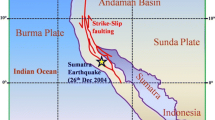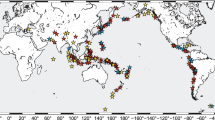“Science does not still perceive clearly that life phenomena and phenomena of inorganic nature considered from the geological, i.e., global, viewpoint are manifestations of a single process.”
V.I. Vernadskii
Abstract
Variations in the annual numbers of representative earthquakes in three areas and six districts of the Baikal rift zone in 1964–2002 were subjected to correlation analysis. Episodes of significant correlations of shock flow rates were found against the background of chaotic seismic activity. They followed the rearrangements (catastrophes) of stresses in the lithosphere, which are also stressing factors for the whole rift geodynamic system. The episode of the late 1970s-early 1980s was particularly long and showed the maximum correlation. Therefore, it can be considered the principal event in seismic process synchronization in the Baikal Rift Zone. The same approach to data analysis revealed similar synchronization and desynchronization phenomena in the behavior of Baikalian turbellaria when they deviated from homeostasis as a result of illumination, which is a stress for this biologic system. Possible reasons for the behavior of biologic and geodynamic systems are discussed in terms of the synergetic concept of phenomena in living and nonliving nature.
Similar content being viewed by others
References
N. A. Agadzhanyan, S. I. Aleksandrov, O. I. Aptikaeva, et al., Human Ecology in the Changing World Ed. by V. A. Chereshneva (Izd. UrO RAN, Yekaterinburg, 2006) [in Russian].
O. I. Aptikaeva, A. G. Gamburtsev, V. A. Galichii, and S. I. Stepanova, “The Use of Biorythmological experiment in Predicting the State of Biological and Geodynamic Systems,” Geofiz. Prots. Biosfera 7(1), 32–52 (2008).
Atlas of Temporal Variations in Natural Processes, Vol. 1: Order and Chaos in the Lithosphere and Other Spheres (OIFZ RAN, Moscow, 1994) [in Russian].
Atlas of Temporal Variations in Natural, Anthropogenic, and Social Processes, Vol. 2: Cyclic Dynamics in Nature and Society (Nauch. mir, Moscow, 1998), p. 432 [in Russian].
Atlas of Temporal Variations in Natural, Anthropogenic, and Social Processes, Vol. 3: Natural and Social Spheres as Environmental Components and Objects of Effects (Yanus-K, Moscow, 2002) [in Russian].
A. G. Gamburtsev, “The Man in Three Surrounding Spheres: Some Preliminary Results of Multidisciplinary Studies,” Geofiz. Prots. Biosfera 7(1), 53–75 (2008).
A. G. Gamburtsev, N. A. Dolbilkina, M. P. Kulagina, et al., “General Characteristics of Temporal Variations according to Data of Different-Scale Seismic Monitoring in Central Asia,” Izv. Akad. Nauk SSSR, Fiz. Zem., No. 9, 73–81 (1991).
R. Ya. Dyganova and N. A. Porfir’eva, Planarians of the Asiatic Part of the USSR: Morphology, Taxonomy, and Distribution (Izd. Kazan. Univ., Kazan, 1990) [in Russian].
A. A. Klyuchevskaya, Extended Abstract of Candidate’s Dissertation in Biology (IGU, Irkutsk, 2007).
A. V. Kluchevsky, “Localization of Initial Actions of a Mantle Diapir in the Baikal Rift Zone,” Dokl. Akad. Nauk 381(2), 251–254 (2001).
A. V. Kluchevsky, “Modern Dynamics of the Baikal Rift and Characteristics of Spatiotemporal Distribution of Strong Earthquakes,” Vulkanol. Seismol., No. 5, 65–78 (2003).
A. V. Kluchevsky, “Self-Similarity of Energy Structure of Seismicity in the Baikal Region,” Dokl. Akad. Nauk 408(1), 96–101 (2006).
A. V. Kluchevsky, “Stresses and Seismicity at the Present Stage of Evolution of the Baikal Rift Zone Lithosphere,” Fiz. Zemli, No. 12, 14-26 (2007).
A. V. Kluchevsky, Extended Abstract of Doctoral Dissertation in Geology and Mineralogy (IZK SO RAN, Irkutsk, 2008).
A. V. Kluchevsky and F. L. Zuev, “Investigation of Seismicity Dynamics in the Baikal Region,” Dokl. Akad. Nauk 409(2), 248–253 (2006).
A. V. Kluchevsky and F. L. Zuev, “Structure of the Epicenter Field of Earthquakes in the Baikal Region,” Dokl. Akad. Nauk 415(5), 682–687 (2007).
E. N. Knyazeva and S. P. Kurdyumov, Principles of Synergetics (Aleteiya, St. Petersburg, 2002) [in Russian].
E. N. Knyazeva and S. P. Kurdyumov, “Life of Nonliving Matter from the Standpoint of Synergetics,” in Self-Organization and Dynamics of Geomorphosystems (Izd. Inst. Optiki Atmosfery, Tomsk, 2003), pp. 3–14 [in Russian].
V. N. Kompanichenko, “Fundamental Properties of Biological Systems and Their Formation during Biosphere Origination,” in Life Development during Abiotic Changes on the Earth, Ed. by O. T. Rusinek and V. A. Fialkov (Sib. Otd. Ross. Akad. Nauk, Novosibirsk, 2008) [in Russian].
Yu. F. Kopnichev, I. P. Bastukas, and I. N. Sokolova, “Pairs of Strong Earthquakes and Geodynamic Processes in Central and Southern Asia,” Vulkanol. Seismol., No. 5, 49–58 (2002).
S. P. Kurdyumov, Regimes with Aggravation: Evolution of Ideas, Ed. by G. G. Malinetskii (Fizmatlit, Moscow, 2006) [in Russian].
G. Nikolis and I. Prigozhin, Cognition of the Complex (Editorial URSS, Moscow, 2003) [in Russian].
V. E. Panin, “Synergetic Principles of Physical Mesomechanics,” Fiz. Mezomekh. 3(6), 5–36 (2000).
N. A. Porfir’eva, The Fauna of Planarians of Lake Baikal (Izd. Kazan. Univ., Kazan, 1973) [in Russian].
A. G. Prozorov, “Algorithm of Forecasting Earthquakes for Pamir and Tyan-Shan by Combination of Remote Aftershocks and Calms,” in Complex Analysis of Geophysical Fields (Nauka, Moscow, 1990), pp. 75–84 [in Russian].
M. A. Sadovskii, “Natural Lumpiness of Rocks,” Dokl. Akad. Nauk SSSR 247(4), 829–831 (1979).
V. B. Smirnov, A. V. Ponomarev, Gian Jiadong, and A. S. Cherepantsev, “Rhytms and Determined Chaos in Geophysical Temporal Series,” Fiz. Zemli, No. 6, 6–28 (2005).
G. A. Sobolev and A. A. Lyubushin, “Microseismic Pulses as Precursors of Earthquakes,” Fiz. Zemli, No. 9, 5–17 (2006).
G. A. Sobolev and A. V. Ponomarev, Physics of Earthquakes and Precursors (Nauka, Moscow, 2003) [in Russian].
I. Yu. Tyurin and V. A. Terekhov, Adaptation in Nonlinear Dynamic Systems (Izd. LKI, Moscow, 2008) [in Russian].
H. Haken, Synergetics (Springer-Verlag, Heidelberg, 1978; Moscow, Mir, 1985).
S. I. Golenetsky, “Problems of Seismicity of Baikal Rift Zone,” J. Geodynam. 11, 293–307 (1990).
A. V. Kluchevsky, “Seismic Moments of Earthquakes in the Baikal Rift Zone As Indicators of Recent Geodynamic Processes,” J. Geodynam. 37(2), 155–168 (2004).
Author information
Authors and Affiliations
Corresponding author
Additional information
Original Russian Text © A.V. Kluchevsky, A.A. Kluchevskaya, 2010, published in Geofizicheskie protsessy i biosfera, 2009, Vol. 8, No. 3, pp. 26–45.
Rights and permissions
About this article
Cite this article
Kluchevsky, A.V., Kluchevskaya, A.A. Stress-associated synchronization and desynchronization in geologic and biologic systems. Izv. Atmos. Ocean. Phys. 46, 879–890 (2010). https://doi.org/10.1134/S000143381007008X
Published:
Issue Date:
DOI: https://doi.org/10.1134/S000143381007008X




